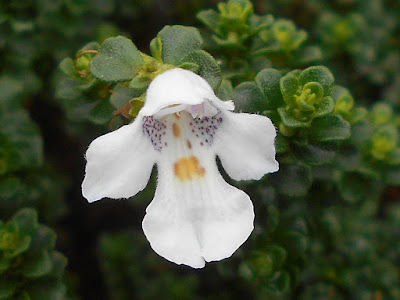Greater Periwinkle, Vinca major, was in flower. It was an escapee from a nearby garden, from whence it had spread vegetatively by stolons, arching downwards and rooting where they touched the soil.
 |
Pretty though it is, Vinca major can become a garden thug and is probably
best avoided. Daventry, 24 October, 2017
|
As far as I know it doesn't produce seed in this country for I can't ever recall finding any plants bearing seeds. It belongs to a largely tropical family, the Apocynaceae, although this particular species is native to southern Europe. The family is generally poisonous, often dangerously so, but one of its old English names - Violet of the Dead (or simply Flower of the Dead) - did not refer to the plant's poisonous properties but from the custom of adorning people condemned to death, with a garland of these flowers placed on the head. It is tempting to believe that this is the origin of its other English name of Periwig but I found, on checking, that the etymology does not support this idea. The Apocynaceae is a large family of plants and includes Oleander, Nerium oleander, which is also very poisonous.
I did a double-take a few yards further on when I saw a small shrub smothered in glossy purple berries, but quickly realised that it was a honeysuckle or, to be more precise, Wilson's Honeysuckle, Lonicera nitida.
 |
Brought back from China by Ernest Wilson, Lonicera nitida, is most
attractive if allowed to produce its fruit. Daventry, 24 October, 2017
|
People could be forgiven for not recognising this evergreen plant, hailing from China, as a honeysuckle at all, as it is quite unlike the twining, deciduous species we are familiar with. The flowers are inconspicuous and, as the plant is often clipped back hard to form tight hedging, the attractive fruits are often lost. It occasionally becomes naturalised.
In our back garden we have a specimen of the Alpine Mint Bush, Prostanthera cuneata. For some reason it has failed to flower this year so I was a little irked to see one blooming quite prolifically along Augustine's Way. This species, from south-east Australia, really is a member of the Mint Family, Lamiaceae, and has a pungent mint smell when rubbed.
 |
The Alpine Mint Bush has flowers typical of the Lamiaceae family.
Daventry, Northants. 24 October, 2017
|
It is quite succulent and when not in bloom vaguely resembles one of the quite unrelated stonecrops.
Finally, on reaching Daventry town centre, I made an interesting discovery regarding the human form. Many years ago I can recall reading to my pupils extracts from a little story called 'Flat Stanley', by Jeff Brown. I had always assumed that flat people such as the eponymous Stan were purely fictitious beings. I was clearly wrong, for some appear to be resident here in Daventry. They even have their own waste bins. We live and learn.
 |
No comments:
Post a Comment